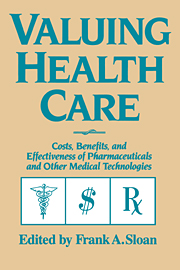 Valuing Health Care
Valuing Health Care Published online by Cambridge University Press: 07 December 2009
In a world with unlimited resources, it would be unnecessary to have methods to determine the best way to allocate those resources among alternative uses. But resources are limited: in 1994, U.S. health spending will exceed $1 trillion for the first time and spending is projected to grow 50 percent faster than gross domestic product for the remainder of the decade (Burner, McKusick, and Waldo 1992). Similar trends are evident in other countries (Schieber, Poullier, and Greenwald 1993). Throughout the world, there are pressures on public budgets. Policymakers and the public have begun to recognize that every dollar spent on health care is no longer available for spending on education, crime control, or infrastructure improvement. Further, much of what we now spend is wasted on care that does not improve our health or yields small improvements in health at exorbitant cost (Siu et al. 1986; Winslow et al. 1988; Enthoven and Kronick 1989; CBO 1992a).
In the public sector, even in the face of mounting cost pressures, the balancing of benefits and costs has typically not been a criterion in deciding whether medical services should be made available or should be covered under public insurance. At one extreme, policymakers have focused exclusively on costs, rejecting higher cost alternatives without any consideration of their potential benefits (e.g., some state Medicaid programs in the United States). Others have focused exclusively on benefits while ignoring the costs of achieving these benefits.
To save this book to your Kindle, first ensure [email protected] is added to your Approved Personal Document E-mail List under your Personal Document Settings on the Manage Your Content and Devices page of your Amazon account. Then enter the ‘name’ part of your Kindle email address below. Find out more about saving to your Kindle.
Note you can select to save to either the @free.kindle.com or @kindle.com variations. ‘@free.kindle.com’ emails are free but can only be saved to your device when it is connected to wi-fi. ‘@kindle.com’ emails can be delivered even when you are not connected to wi-fi, but note that service fees apply.
Find out more about the Kindle Personal Document Service.
To save content items to your account, please confirm that you agree to abide by our usage policies. If this is the first time you use this feature, you will be asked to authorise Cambridge Core to connect with your account. Find out more about saving content to Dropbox.
To save content items to your account, please confirm that you agree to abide by our usage policies. If this is the first time you use this feature, you will be asked to authorise Cambridge Core to connect with your account. Find out more about saving content to Google Drive.